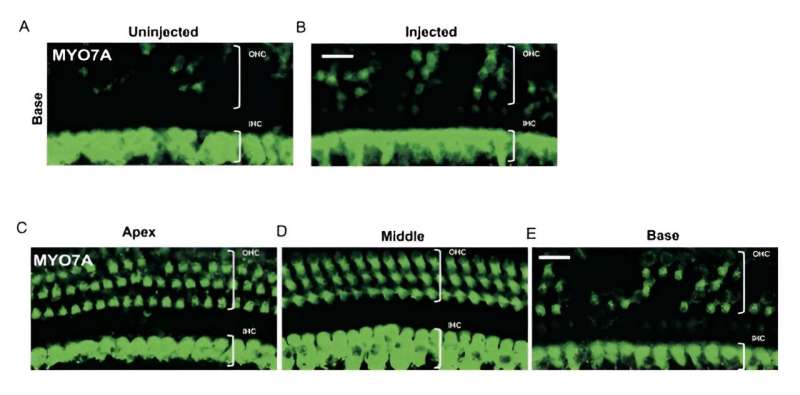This article has been reviewed according to Science X's editorial process and policies. Editors have highlighted the following attributes while ensuring the content's credibility:
fact-checked
peer-reviewed publication
trusted source
proofread
Novel genome editing approach restores hearing in adult preclinical models with genetic deafness

Mass Eye and Ear researchers restored hearing in preclinical mouse models with a specific form of inherited deafness called DFNA50 caused by mutations in microRNA, by using a novel in vivo CRISPR genome editing approach. Since mouse and human microRNAs have identical sequences, the researchers hope this work can one day be translated into applications for humans.
The study also looked at safety of the AAV-mediated genome editing approach and found it had a good safety profile that includes little off-target effect and no detectable long-term integration of the AAV vector in the genome.
"Our research suggested minimal potential risk and supports the feasibility of future clinical applications in humans," said Wenliang Zhu, Ph.D., and physician-scientist Wan Du, MD, Ph.D., members of Chen's lab at Mass Eye and Ear and first authors on the paper.
The study, led by Zheng-Yi Chen, DPhil, an associate scientist in the Eaton-Peabody Laboratories at Mass Eye and Ear, was published July 10 in Science Translational Medicine.
"Our findings provide a promising pathway for developing treatments by editing for many forms of genetic hearing loss," said Chen, who is the Ines and Fredrick Yeatts Chair in Otolaryngology at Mass Eye and Ear and an associate professor in Otolaryngology–Head and Neck Surgery at Harvard Medical School.
"With further study, our intervention using genome editing could potentially halt or reverse hearing loss progression in affected individuals, including adults."
About one in 500 newborns suffer from genetic hearing loss and currently there are not any approved therapeutics to treat deafness.
In the new study, researchers targeted a specific mutation in the microRNA-96 (MiR-96) gene that causes progressive hearing loss in mice and plays a crucial role in regulating gene expression in hair cells (sensory cells responsible for hearing) of mammals.
In humans, this mutation has been identified as a cause of a form of dominant inherited progressive hearing loss called DFNA50. The researchers created a mouse model carrying the mutation that mirrored the progressive hearing loss in humans with DFNA50; by four weeks of age, these models exhibited complete hearing loss at high frequencies.
The team employed a CRISPR/Cas9 genome editing approach to target and disrupt this mutation, which was delivered to the inner ear through an injection of an adeno-associated virus (AAV) carrying the editing machinery. They compared injections at two time points, during early development and adult stages, and demonstrated robust preservation of auditory function in both cases long term, with earlier intervention proving most optimal.
The study also looked at safety of the AAV-mediated genome editing approach and found it had a good safety profile that includes little off-target effect and no detectable long-term integration of the AAV vector in the genome. This suggested minimal potential risk and supports the feasibility of future clinical applications in people.
Chen and his team have designed a construct to contain all known microRNA mutations to be used in humans, and in conjunction with Mass General Brigham's Gene and Cell Therapy Institute, plan to conduct IND-enabling studies in additional preclinical models in the hopes of moving this treatment approach into a first-in-human clinical trial.
Studies like this one show the promise of gene therapy for treating conditions such as hearing loss. Mass General Brigham's Gene and Cell Therapy Institute is helping to translate scientific discoveries made by researchers into first-in-human clinical trials and, ultimately, life-changing treatments for patients.
This latest research from Chen and colleagues marks a significant step forward in the field of gene therapy for hearing disorders, offering hope for future clinical trials aimed at restoring auditory function in people with genetic forms of hearing impairment.
Chen and his collaborators have also conducted clinical trials looking at a different gene therapy approach for another form of deafness, DFNB9 caused by mutations in the OTOF gene. That clinical trial in China has demonstrated positive results in children treated in one and both ears.
Chen hopes the technology developed in the OTOF trial, such as minimally invasive AAV delivery into the human inner ears, will accelerate the development of editing therapy into the clinic.
"With more than 150 forms of genetic deafness, our research offers further hope for patients that previously lacked any options beyond a cochlear implant," said Chen.
"These findings suggest a need for more rigorous studies building on proof-of-concept papers like these, to achieve our goal of developing different treatment approaches to target every one of these mutations."
More information: Wenliang Zhu et al, Targeted genome editing restores auditory function in adult mice with progressive hearing loss caused by a human microRNA mutation, Science Translational Medicine (2024). DOI: 10.1126/scitranslmed.adn0689


















